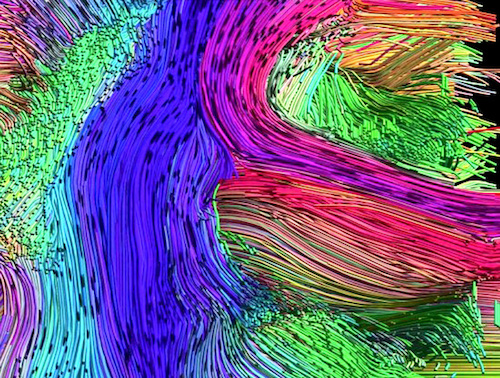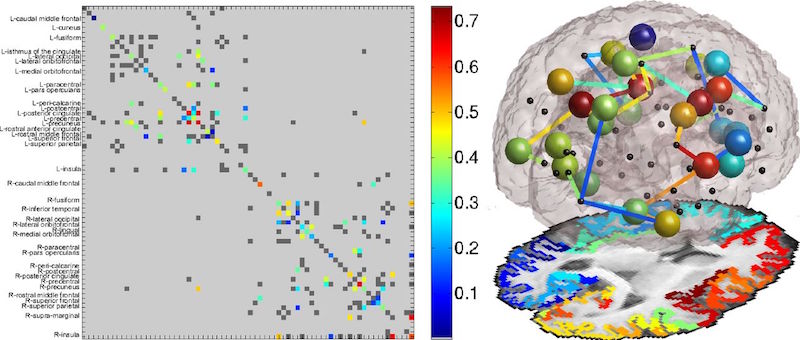Connectomics & Diffusion Imaging
Diffusion Imaging
The majority of our projects involve Diffusion Weighted Imaging (DWI) -- a type of MRI scan that resolves the water diffusivity along each direction for each volume unit (voxel) across the entire brain. Due to fascicle geometry in the white matter, we are able reconstruct neuronal pathways (tracts) between grey matter regions. Even the most basic reconstruction, Diffusion Tensor Imaging (DTI), which models the diffusion process as a simple ellipsoid, allows for a wide variety of clinical analyses, with wide-ranging results in varied domains, such as specific diseases (e.g. Alzheimer's disease, Parkinson's disease, bipolar disorder, schizophrenia, chronic and acute stroke), as well as neuro-typical Development and Aging, Traumatic Brain Injury and recovery, Gender and demographic differences, and genetic studies of brain macro/meso-architecture.
Our lab also develops more advanced diffusion models and methods, including the utilization of high-angular resolution diffusion imaging (HARDI), the development of new local diffusion models, and the development and validation of new (global) tractography methods.

Further Reading
- Nir TM, Jahanshad N, Villalon-Reina JE, Toga AW, Jack CR, Weiner MW, Thompson PM, Alzheimer's Disease Neuroimaging Initiative (ADNI). Effectiveness of regional DTI measures in distinguishing Alzheimer's disease, MCI, and normal
aging. NeuroImage: Clinical. 2013 Dec 31;3:180-95. [link]
- Zhan L, Zhou J, Wang Y, Jin Y, Jahanshad N, Prasad G, Nir TM, Leonardo CD, Ye J, Thompson PM, Alzheimer’s Disease Neuroimaging Initiative. Comparison of nine tractography algorithms for detecting abnormal structural brain networks
in Alzheimer’s disease. Frontiers in aging neuroscience. 2015 Apr 14;7:48. [link]
- Leow AD, Zhu S, Zhan L, McMahon K, de Zubicaray GI, Meredith M, Wright MJ, Toga AW, Thompson PM. The tensor distribution function. Magnetic Resonance in Medicine. 2009 Jan 1;61(1):205-14. [link]
- Zhan L, Leow AD, Jahanshad N, Chiang MC, Barysheva M, Lee AD, Toga AW, McMahon KL, de Zubicaray GI, Wright MJ, Thompson PM. How does angular resolution affect diffusion imaging measures?. Neuroimage. 2010 Jan 15;49(2):1357-71. [ link]
Connectomics
Connectomics is the study of brain connectivity. Usually represented by a network of brain macro-scale regions connected by either diffusion-recovered tracts or estimated activity (e.g. fMRI BOLD), in recent years connecitivity has been the focus of much research in the neuroimaging community. Projects at the IGC include Rich Club analyses, developmental connectomics, the ENIGMA working group for connectivity, connectivity and genetics, as well as investigating structural connectivity from a clinical perspective (i.e. the effect of disease on the connectome). Ongoing projects also involve alternate representations of connectivity, including a recent paper on continuous representations of connectivity.


Further Reading
- Daianu M, Jahanshad N, Nir TM, Toga AW, Jack Jr CR, Weiner MW, Thompson PM, for the Alzheimer's Disease Neuroimaging Initiative PM. Breakdown of brain connectivity between normal aging and Alzheimer's disease: a structural
k-core network analysis. Brain connectivity. 2013 Aug 1;3(4):407-22. [link]
- Zhan L, Zhou J, Wang Y, Jin Y, Jahanshad N, Prasad G, Nir TM, Leonardo CD, Ye J, Thompson PM, Alzheimer’s Disease Neuroimaging Initiative. Comparison of nine tractography algorithms for detecting abnormal structural brain networks
in Alzheimer’s disease. Frontiers in aging neuroscience. 2015 Apr 14;7:48. [link]
- Dennis EL, Jahanshad N, McMahon KL, de Zubicaray GI, Martin NG, Hickie IB, Toga AW, Wright MJ, Thompson PM. Development of brain structural connectivity between ages 12 and 30: a 4-Tesla diffusion imaging study in 439 adolescents
and adults. Neuroimage. 2013 Jan 1;64:671-84. [link]
- Thompson PM, Hibar DP, Stein JL, Prasad G, Jahanshad N. Genetics of the Connectome and the ENIGMA Project. In Micro-, Meso-and Macro-Connectomics of the Brain 2016 (pp. 147-164). Springer International Publishing. [link]
- Jahanshad N, Rajagopalan P, Hua X, Hibar DP, Nir TM, Toga AW, Jack CR, Saykin AJ, Green RC, Weiner MW, Medland SE. Genome-wide scan of healthy human connectome discovers SPON1 gene variant influencing dementia severity. Proceedings
of the National Academy of Sciences. 2013 Mar 19;110(12):4768-73. [link]
- Moyer D, Gutman BA, Faskowitz J, Jahanshad N, Thompson PM. A Continuous Model of Cortical Connectivity. InInternational Conference on Medical Image Computing and Computer-Assisted Intervention 2016 Oct 17 (pp. 157-165). Springer International Publishing. [link]